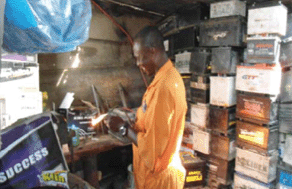Bioaccessibility of lead in airborne particulates from car battery repair work
Abstract
The bioaccessibility of Pb in air particulate matter from two car battery repair workshops in Kumasi (Ghana) was measured (64 full shift personal aerosol samples). An artificial lung lining fluid simulant (Hatch solution) was applied for leaching the bioaccessible fraction in half of the samples, the other half was leached with synthetic gastric juice. At both locations, the Pb solubility (median) in gastric juice (89% and 92%) is substantially higher than in Hatch solution (4.9% and 5.6%). The high solubility of Pb in gastric juice may be related to the presence of Pb oxides. The low bioaccessibility of Pb in Hatch solution is in good agreement with previous work on mine tailings, urban aerosol, car exhaust, welding fumes and indoor dust. The high bioaccessibility of Pb in the gastrointestinal tract underpins the importance of improving the personal hygienic behavior at the workplace. It is recommended that air monitoring of Pb should include the extrathoracic aerosol fraction using inhalable aerosol samplers, as particles of this size fraction are most likely transferred to the gastrointestinal tract in addition to the non-lung-soluble particles transported from the lung by mucociliary and phagocytosis clearance.


 Please wait while we load your content...
Please wait while we load your content...